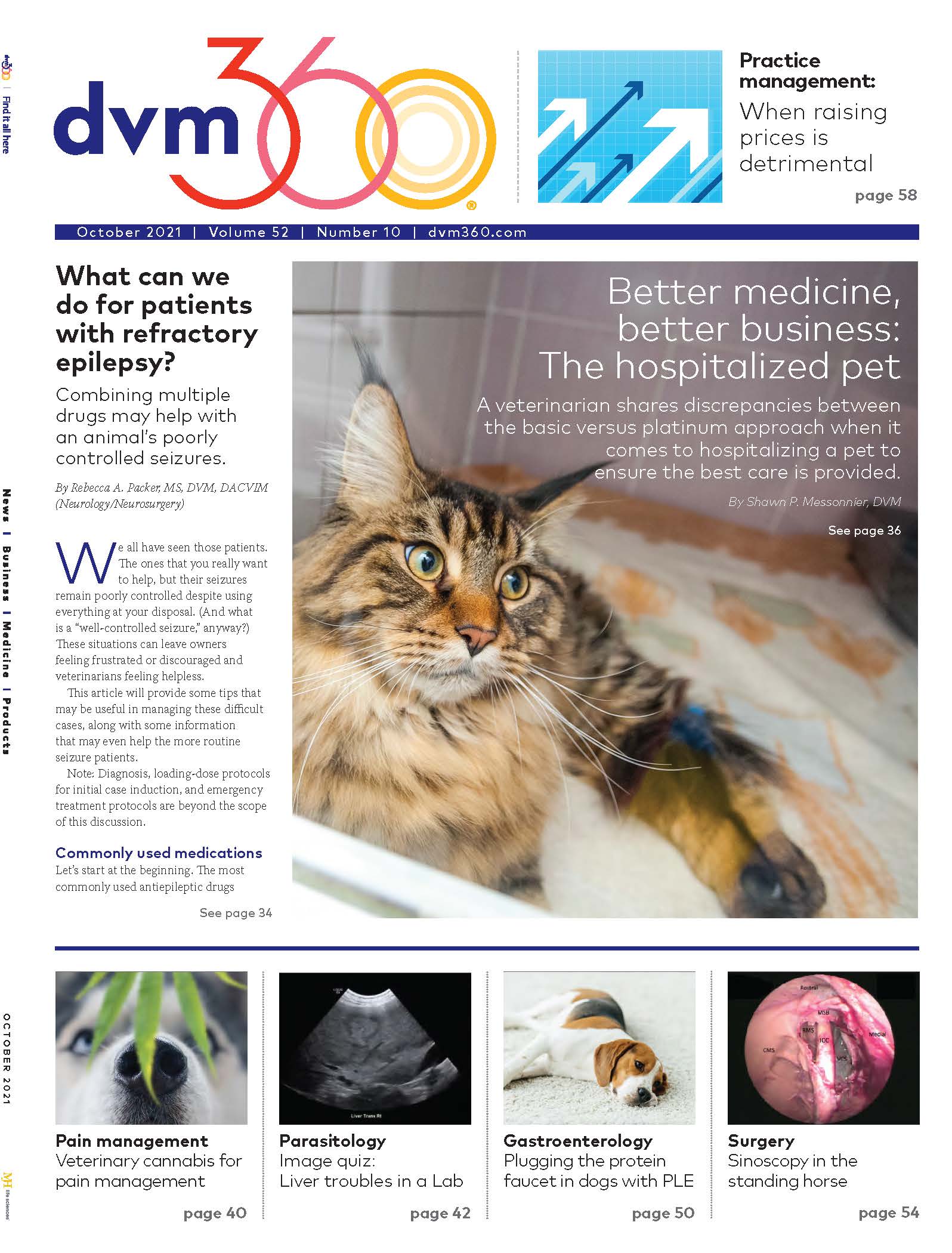Plugging the protein faucet in dogs with PLE
A leaky gut has several potential backstories. But every type of “protein-losing enteropathy” (PLE) shares a common loss: albumin, a vital protein that regulates the oncotic pressure of blood, among other things. Although dogs with PLE are quite sick, advances in diagnostics and treatments have improved outcomes.
“It used to scare us,” said Scott Owens, DVM, MS, DACVIM, an internist at MedVet Indianapolis. “But now we have high success rates with treating and managing these dogs.”
Healthy dogs lose regulated amounts of protein through the gastrointestinal (GI) tract and the kidneys, but hypoproteinemia can result from excessive loss secondary to protein-losing enteropathy (PLE). Other conditions that can result in hypoproteinemia include protein-losing nephropathy (PLN) and decreased hepatic synthesis. The key feature of PLE is panhypoproteinemia, due to the loss of both small (albumin) and large (globulin) proteins. On a normal basis, anywhere from 10% to 50% of the total protein loss funnels through the gut1,2; however, more than this amount leads to PLE.3
Hypoproteinemia was once thought to result solely from decreased protein synthesis. But in 1949, investigators discovered increased GI losses to be the major cause. In 1957, radioactive iodine tags were hitched onto albumin so it could be followed along its journey through the intestines.
More of a syndrome than a discrete “disease,” PLE is now known to have etiologies that can vary between dogs as well as between species.
“PLE is not a diagnosis,” Owens said. “It’s just a beginning. You need to figure out what the underlying cause is.”
In humans, this underlying cause is usually either cardiovascular disease, liver disease, ulcerative colitis or Crohn disease. In cattle, Johne’s disease can result in protein loss from the gut, whereas equine PLE is often associated with GI ulcers and infectious diarrhea (eg, salmonellosis). In dogs, inflammatory bowel disease (IBD) is often the main suspect.
Mammalian species have a conserved microarchitecture that facilitates the absorption of nutrients from ingested food. Millions of raised villi line the intestinal tract. Within each villus, venules, arterioles and capillaries surround a central lacteal, which drains nutrients that cross the mucosa but are too large to be absorbed into the vasculature. The lacteals transport these particles, primarily dietary fats, to larger lymphatic vessels and then to the liver.
The job of the lacteals, Owens explained, is to “pick up the mess from all the leftovers that can’t be absorbed through the veins.”
Several different pathologies can disrupt this process. Anything that alters mucosal permeability and integrity can precipitate protein loss. These include erosions, foreign bodies, neoplasia, infection (eg, parvovirus, parasites), and inflammation (IBD).4
Protein leakage can also result when lacteals burst despite a healthy intestinal mucosa, a condition called lymphangiectasia.4 Although lacteals are flexible and can distend easily, Owens noted, “they hit that breaking point and then they all start popping and you get this massive, acute protein loss.”
In dogs, PLE is typically associated with either lymphangiectasia or lymphoplasmacytic enteritis.5
Several breeds are predisposed to PLE. In Yorkshire terriers, lymphangiectasia can be primary (defective, dilated lacteals) or secondary (lymphatic obstruction due to portal hypertension).6 In either case, Owens explained, “they ooze tons and tons of protein.” These yorkies often arrive acutely ill, with albumin levels as low as 0.8 g/dL (normal range, 2.6-4.0 g/dL).
Other breeds that are genetically predisposed to PLE include soft-coated wheaten terriers (specifically, a PLE/PLN complex possibly associated with food allergy7) and Norwegian lundehunds (a severe chronic enteropathy seen in virtually all dogs in this breed due to genetic bottleneck8), as well as Rottweilers, German shepherds, and shar-peis (all prone to chronic enteropathies).
Dogs with PLE often present with small- or mixed-bowel diarrhea, although some 30% of them do not have diarrhea as part of their clinical picture. Weight loss is typical and vomiting is rare. Some dogs can present with edema and pleural effusion due to severe protein loss.
Blood work may show hypoalbuminemia or panhypoproteinemia, hypocholesterolemia, lymphopenia, hypocalcemia and hypomagnesemia. Hepatic or renal protein loss should be investigated with a urinalysis, as well as an evaluation of serum liver enzymes and bile acids.
Coagulopathies (hyper- and hypocoagulopathies) may also be present due to associated vitamin D or K deficits or loss of antithrombin III. In a study of 138 dogs with PLE, 15% had evidence of clot formation.
Lacteals, normally microscopic, may be visible on an ultrasound when dilated. During an endoscopy, lymphangiectasia appears as a speckled white pattern within the small intestine. IBD, on the other hand, features cobbly intestinal mucosa.9 Owens recommends administering corn oil 3 to 4 hours prior to endoscopy, thereby making the lacteals swell so they are easier to visualize. Endoscopic versus surgical biopsies are preferred in patients with severe hypoalbuminemia due to the postoperative risk for dehiscence in these compromised tissues.
The presence of hypoalbuminemia is a major factor informing treatment and prognosis.10
In a study involving 80 dogs with IBD, 20% had hypoalbuminemia. Of the 10 dogs that were euthanized, 7 had hypoalbuminemia.
Another study found shorter survival times (701 days) in dogs with hypoalbuminemia compared with those with normal albumin. Approximately 75% of dogs survived the acute period, the crucial first month. Additionally, the extent of the hypoalbuminemia did not correlate with outcome: A dog with mild hypoproteinemia did not necessarily fare better than one with severe protein loss.
For dogs whose hypoalbuminemia was caused by intestinal lymphoma—rarer and more serious in dogs than in cats—survival times ranged from 2 weeks to 2 months, according to results from one study.
The main goal of therapy is to harness albumin loss. Acute cases require more aggressive treatment than those that have been festering for a while. If the albumin level is less than 1.5 g/dL, fluids are likely to go straight to the chest because there is not enough albumin to trap them in the vasculature. To avoid third-spacing of fluids, Owens recommends using half crystalloids and half colloids. If colloids are not available, fresh frozen plasma can be used; however, large amounts may be needed to substantially raise oncotic pressure.
If mild pleural effusion is present but the patient is eupneic, Owens cautions against thoracocentesis because it could lead to further albumin loss.
Antibiotics should be used only if diarrhea is present. Intravenous metronidazole can be given in the hospital, and then the patient can be sent home with oral metronidazole; tylosin can be used as an alternative.11
If biopsies confirm that the PLE has an inflammatory component, as is usually the case, immunosuppressants play a huge role. According to Owens, most dogs respond to prednisone. Budesonide may also be effective,12 and result in less systemic absorption, particularly important if heart disease is also present. For those whose hypoalbuminemia is severe or refractory to steroids, a second immunosuppressant can be considered. Cyclosporine is the gold standard for additive therapy,13 but chlorambucil or azathioprine can also be used.14
Anticoagulants are used in dogs with hypercoagulopathies, and vitamin supplementation with cobalamin (vitamin B12) can be used in case of cobalamin deficiency.
In the case of lymphangiectasia, low-fat diets such as Royal Canin Gastrointestinal Low Fat dog food, Hill’s Prescription Diet i/d Sensitive and home-cooked chicken or potato-type meals should be implemented.15 For patients with food allergies or IBD, hypoallergenic diets can help to seal the gut.
References
- Hall EJ, German AJ. Diseases of the small intestine. In: Ettinger SJ, Feldman EC, eds. Textbook of Veterinary Internal Medicine. 7th ed. Saunders; 2009:1526-1572.
- Moore LE. Protein-losing enteropathy. In: Bonagura JD, Twedt DC, eds. Kirk’s Current Veterinary Therapy XIV. 14th ed. Saunders; 2008:512-515.
- Greenwald DA. Protein-losing gastroenteropathy. In: Feldman M, Friedman LS. Brandt LJ, eds. Sleisenger and Fordtran’s Gastrointestinal and Liver Disease. 8th ed. Saunders; 2006:557-564.
- Bode L, Salvestrini C, Park PW, et al. Heparan sulfate and syndecan-1 are essential in maintaining murine and human intestinal epithelial barrier function. J Clin Invest. 2008;118(1):229-238. doi:10.1172/JCI32335
- Peterson PB, Willard MD. Protein-losing enteropathies. Vet Clin North Am Small Anim Pract. 2003;33(5):1061-1082. doi:10.1016/s0195-5616(03)00055-x
- Kimmel SE, Waddell LS, Michel KE. Hypomagnesemia and hypocalcemia associated with protein-losing enteropathy in Yorkshire terriers: five cases (1992-1998). J Am Vet Med Assoc. 2000;217(5):703-706. doi:10.2460/javma.2000.217.703
- Littman MP, Dambach DM, Vaden SL, Giger U. Familial protein-losing enteropathy and protein-losing nephropathy in Soft Coated Wheaten Terriers: 222 cases (1983-1997). J Vet Intern Med. 2000;14(1):68-80. doi:10.1892/0891-6640(2000)014<0068:fpleap>2.3.co;2
- Berghoff N, Ruaux CG, Steiner JM, Williams DAA. Gastroenteropathy in Norwegian Lundehunds. Compend Contin Educ Vet. 2007;29(8):456-465.
- Kull PA, Hess RS, Craig LE, Saunders HM, Washabau RJ. Clinical, clinicopathologic, radiographic, and ultrasonographic characteristics of intestinal lymphangiectasia in dogs: 17 cases (1996-1998). J Am Vet Med Assoc. 2001;219(2):197-202. doi:10.2460/javma.2001.219.197
- Owens SL, Parnell NK, Moore GE, et al. Canine protein-losing enteropathy: a retrospective analysis and survival study in 68 dogs (abstr). J Vet Intern Med. 2011;25(3):692-693.
- Kilpinen S, Spillmann T, Westermarck E. Efficacy of two low-dose oral tylosin regimens in controlling the relapse of diarrhea in dogs with tylosin-responsive diarrhea: a prospective, single-blinded, two-arm parallel, clinical field trial. Acta Vet Scand. 2014;56(1):43. doi:10.1186/s13028-014-0043-5
- Dye TL, Diehl KJ, Wheeler SL, Westfall DS. Randomized, controlled trial of budesonide and prednisone for the treatment of idiopathic inflammatory bowel disease in dogs. J Vet Intern Med. 2013;27(6):1385-1391. doi:10.1111/jvim.12195
- Allenspach K, Rüfenacht S, Sauter S, et al. Pharmacokinetics and clinical efficacy of cyclosporine treatment of dogs with steroid-refractory inflammatory bowel disease. J Vet Intern Med. 2006;20(2):239-244. doi:10.1892/0891-6640(2006)20[239:paceoc]2.0.co;2
- Dandrieux JR, Noble PJ, Scase TJ, Cripps PJ, German AJ. Comparison of a chlorambucil-prednisolone combination with an azathioprine-prednisolone combination for treatment of chronic enteropathy with concurrent protein-losing enteropathy in dogs: 27 cases (2007-2010). J Am Vet Med Assoc. 2013;242(12):1705-1714. doi:10.2460/javma.242.12.1705
- Okanishi H, Yoshioka R, Kagawa Y, Watari T. The clinical efficacy of dietary fat restriction in treatment of dogs with intestinal lymphangiectasia. J Vet Intern Med. 2014;28(3):809-817. doi:10.1111/jvim.12327
Joan Capuzzi, VMD, is a small animal veterinarian and journalist based in the Philadelphia area.


